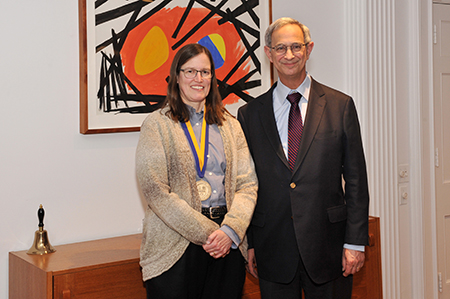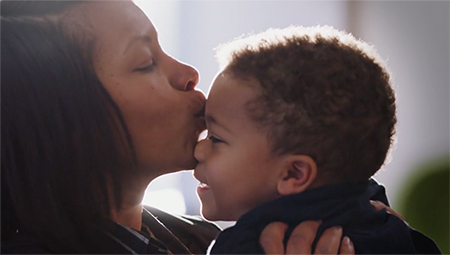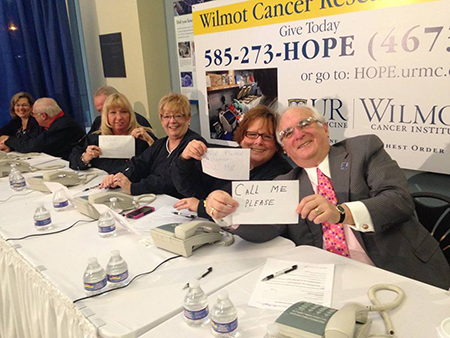Super Medicine
A screenshot from "You Are My Sunshine," one of the two new UR Medicine ads that will air during Super Bowl 50
This Sunday, the best of the NFL and the University of Rochester will share a stage. Two new television ads will highlight the work of the University’s researchers and clinicians. One highlights the awe-inspiring number of Rochester researchers working to discover preventions and cures for some of the world’s most devastating diseases and medical conditions. The other features real patients and families receiving treatment at Golisano Children’s Hospital. Both will leave you feeling proud that you support the University of Rochester.
See them now:
3,000 Researchers
You Are My Sunshine
Success and A New Challenge

It’s the friend or family member who’s a cancer survivor. It’s the newborn going home after more than 200 days in intensive care. It’s the researcher working on the key to preventing Alzheimer’s disease. It was with these people in mind that the Medical Center community celebrated reaching its $650 million goal for The Meliora Challenge in early January 2016.
And it was in the spirit of Medicine of the Highest Order that the goal was raised. Now, the Medical Center aims to hit a stretch goal of $700 million by June 30.
Coming this far would not have been possible without the partnership and philanthropy of the URMC campaign co-chairs, Trustees E. Philip Saunders and Richard T. Aab, and honorary chair, Trustee Danny Wegman, as well as scores of additional volunteers and donors.
Together, URMC campaign leaders and donors, who have given at all levels, have had a transformative effect on the Medical Center and the region. The new Golisano Children’s Hospital offers an environment that is specifically designed for the 85,000 children it provides care to every year. Wilmot Cancer Institute has grown from its hub at the Medical Center into a network of 11 locations to provide close-to-home access to precision medicine, clinical trials, and expertise. Students and faculty are also benefitting from the support of 116 new scholarships and fellowships and 53 new professorships.
Not unlike most campaigns that reach their primary goal, the URMC campaign has objectives it has yet to meet. These areas will be a focus in the pursuit of the $700 million stretch goal.
Those passionate about nursing can help the School of Nursing raise $4 million to meet its $25 million goal by supporting faculty endowment and student scholarships. Faculty support remains a priority across the URMC. Endowed professorships and research funds are critical for better understanding the mechanisms of disease and the development of new therapies and, one day, preventions and cures for disease.
From the outside, and even most places inside, the new Children’s Hospital looks finished. But there's still $8 million to raise and the fourth and sixth floors, part of Phase II, are under construction. Phase II includes the William and Mildred Levine Pediatric Surgical Suite, which features six state-of-the-art operating rooms dedicated to children, and an expanded Pediatric Intensive Care Unit and Pediatric Cardiac Intensive Care Unit. The Medical Center is also raising funds for the new pediatric autism clinic and associated programs.
In the final months of The Meliora Challenge, the continued leadership and generosity of University alumni, parents, and friends will enable the URMC to strive for ever better patient care, nursing, dental, and medical education, and the groundbreaking research that has potential to save and improve lives.
Wilmot raises more than $24,000 for cancer research
Volunteers staff the phones during Wilmot Cancer Research Day
Research is a key part of the Wilmot Cancer Institute’s mission, and in the wake of a tremendously successful Wilmot Cancer Research Day on January 20, the greater Rochester community is learning why that’s important.
As of January 22, the Institute has raised $24,540 as part of Wilmot Cancer Research Day, a partnership with 13WHAM/Fox Rochester. Anchor Jennifer Johnson served as emcee for the day, and over the course of the event, she did nine live interviews with clinicians, researchers and community groups in the Strong Memorial Hospital lobby. She also highlighted stories featuring patients Judy Jansson and Melanie Haers, who have participated in clinical trials.
“The fact that we have precision medicine for cancer right now is all based on molecular research,” said Hartmut “Hucky” Land, co-director of the Wilmot Cancer Institute, the Institute's director of research, and the Robert and Dorothy Markin Professor. “There are success stories and, of course, without research those success stories wouldn’t exist.
Gifts came by phone to 55 volunteers—including many staff members—who worked a phone bank for eight hours. They continue to come in online through hope.urmc.edu.
At Wilmot, 100 investigators from across disciplines are working together to advance the understanding and treatment of cancer. Their work spans the laboratory (where scientists focus on the biology of cancer and what makes cells malignant) to the clinic (where patients have access to nearly 200 clinical trials which offer novel treatments before they’re widely available).
To learn more about the importance of research at Wilmot Cancer Institute and how community support makes progress against these diseases possible, visit the Wilmot Cancer Research Day website.
Beyond the Inner Ear

Laurel Carney and Joel Seligman
Through the auditory canal, past the ear drum, and beyond the cochlea is where you will find the research of Laurel Carney, Ph.D. Carney is studying the complex network of auditory nerve fibers that transmit the inner ear’s electrical signals to the brain.
Why? For better hearing aids.
Carney’s research combines neurophysiological and behavioral studies with computer modeling in a quest to find the key to creating hearing aids that make human speech louder and clearer. In June 2015, her efforts earned her the William and Christine Hartmann Prize in Auditory Neuroscience from the Acoustical Society of America. On January 22, the University recognized her work at a ceremony that formally installed her as the Marylou Ingram Professor in Biomedical Engineering.
Somewhere, Carney is receiving applause from the namesake and creator of her professorship, the late Marylou Ingram ’42, ’47M (MD). After paving the way for aspiring female scientists coming through the University, Ingram had a distinguished career in academic medicine and medical research and education that lasted until her death in 2013, at the age of 93.
“Dr. Ingram will be remembered as one of the preeminent scientists of her time, a legacy she further enriched by establishing this professorship,” said President and CEO Joel Seligman. “Her excellence and commitment to her research are now the standards our faculty must live up to. A holder of several patents, widely published, and winner of several honors, Laurel Carney is an exemplary inaugural holder of the Ingram Professorship.”
Carney’s work has appeared in the Journal of Neuroscience, Journal of Neurophysiology, Journal of the Acoustical Society of America, and Journal of the Association for Research in Otolaryngology, among many other publications. In 2011, she was selected as Engineering Professor of the Year by the University of Rochester Students’ Association.
“Laurel is one of those special faculty members who is able to strike a balance between exceptional research, exceptional teaching, and exceptional service to her colleagues and profession,” said Robert Clark, Ph.D., senior vice president of Research and dean of the Hajim School of Engineering & Applied Sciences. “Her scholarly work and leadership in the classroom left no questions about her being the first Ingram Professor.”
Easing a Global Burden

Robert Holloway, Mark Taubman, Gretchen Birbeck, and Joel Seligman
Six months of every year, Zambia’s rural Southern Province is home to neurologist Gretchen Birbeck, M.D., M.P.H., D.T.M.H.
Birbeck is the founding director of Chikankata Hospital’s Epilepsy Care Team, a title she gained from curiosity. As a medical student, Birbeck undertook a rotation at the sub-Saharan hospital because she was interested in seeing how medicine was being practiced without the aid of advanced technology and resources that are available in the United States. What she saw was a “soul crushing” lack of treatment for epilepsy, a neurological disorder characterized by recurrent seizures. She returned, and continues to return, to Zambia to help address the problem.
Birbeck’s research on neurologic disorders in resource-limited tropical settings is among the reasons she is the inaugural holder of the Edward A. and Alma Vollertsen Rykenboer Professorship in Neurology.
The professorship was created through a bequest from its namesakes, the late couple Edward A. Rykenboer, a member of the University’s Class of 1912, and Alma Vollertsen Rykenboer. Their estates also established the Edward A. and Alma Vollertsen Rykenboer Chair in Neurophysiology.
“Neurological disorders constitute a significant health problem in our society today,” said President and CEO Joel Seligman. “Thanks to the Rykenboers’ generosity, we are able to recognize one of the faculty members leading efforts in this global burden at the University. Gretchen’s distinguished work, especially in the vulnerable populations of Africa, makes her uniquely worthy of this honor.”
In addition to her work in Zambia, Birbeck is currently a collaborator in cerebral malaria research and neuro-HIV clinical trials in Uganda. She also mentors post-graduate fellows and junior faculty conducting research in Zambia, Malawi, Kenya, and South Africa.
“Gretchen considers herself lucky to be at Rochester because it is the ‘center of the universe for neurological clinical trials,’” said Mark B. Taubman, M.D., CEO of the URMC and UR Medicine and dean of the School of Medicine and Dentistry. “But we are the lucky ones. We are fortunate to have such a great leader and innovator in neurological disorders on our faculty and in our community.”

